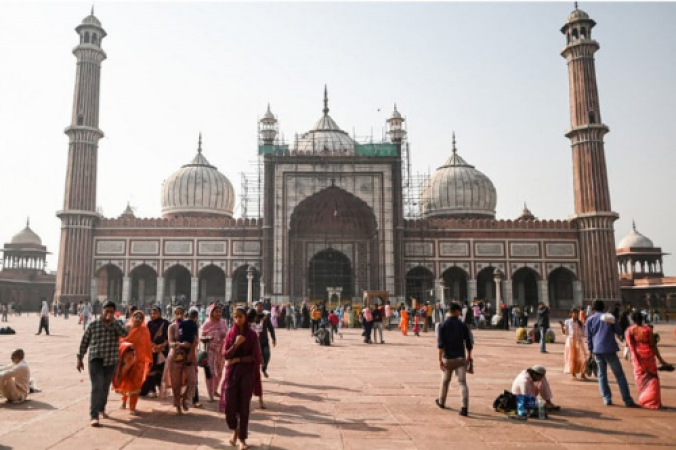
New Delhi: The Taj Mahal is the most well-known example of Middle Eastern influence on Indian architecture, but it's not the only stunning example of the distinctive design that evolved over centuries as a fusion of Arab, Persian, and indigenous designs.
Although Islamic art had already influenced local culture since the Arabs conquered the Sindh region, which is now in Pakistan, in 712, the earliest examples of Islamic architecture that have survived in the Indian subcontinent date from the late 12th century.
Muslims brought new features and architectural techniques to India, including the use of the arch and dome, which Hindu craftsmen who had long since mastered the art of building further perfected.
Also Read: China downplays the cancellation of Blinken's trip due to a balloon
The oldest still standing mosque in India is the Quwwat-ul-Islam Mosque, which is part of the Qutb Minar complex in Delhi. Qutb-ud-din Aibak, a Turkic general who later rose to power as the first Sultan of Delhi, started work on building it in 1192.
Although the mosque's arched facade has an Islamic aesthetic, it has Indian features like rich floral ornamentation.
"Cultural exchanges began during the Sultanate era...
Also Read: Zelensky and Scholz reach a "consensus" that Russians are not hit by Western weapons
Hindu architecture influenced mosque architecture as a result of the arrival of Turks and their interactions with the local population, according to Syed Ali Nadeem Rezavi, a history professor at Aligarh Muslim University and the organization's secretary.
"Architects and engineers from Iran, the Arab world, and Central Asia were imported by Muslim rulers... however, the skilled artisans and craftspeople were locals. The synthesis of traditions was the end result.
As time went on, new Muslim powers entered India and brought with them their cultural legacy. Local sultanates also emerged and flourished at this time, taking on their own forms. During the period of Muslim supremacy, the Hindu kingdoms that maintained varying degrees of independence also created significant works and influenced prevailing fashions.
An architecture that resulted from these multilevel interactions was neither strictly Islamic nor strictly Hindu.
In many locations in Gujarat, mosques and temples are difficult to spot. Temples in the Hindu city of Ayodhya in northern India resemble mosques because they have domes, according to Rezavi, speaking to Arab News. "Hindus and Muslims cannot be discussed in the context of India's history. They were identical to one another.
They took on each other's distinguishing traits. ” However, the Mughals were responsible for the Indo-Islamic style's apogee. With works that are still examples of the highest quality and refinement today, the Mughal dynasty, which ruled the subcontinent between the 16th and 19th centuries, signalled the global revival of Islamic architecture.
The Mughals, who were originally from Central Asia, brought with them cultural motifs taken from the Arabs, Persians, and Ottomans. They combined them with the various provincial styles they discovered in their new lands as they settled in India.
According to Anuj Srivastva, one of the most well-known Indian architects who teaches at the New Delhi School of Planning and Architecture, it is understandable why the British considered Mughal architecture to be the archetypal Indian style when they ruled the subcontinent in the 19th century.
"Indo-Saracenic architecture is a fusion of various architectural types. According to him, it borrowed decorative and stylistic features from indigenous Indo-Islamic architecture.
The Mughals brought Central Asian, Arab, and Persian influences with them when they invaded, and they developed their own style and incorporated it with the pre-existing architecture in India.
The Mughal dynasty's architecture began with the tomb of Humayun, the son of Babur, who founded the Mughal Empire, in 1570. The Taj Mahal was built three generations after the first garden tomb on the subcontinent, which served as an inspiration for numerous other significant architectural innovations.
The enormous fort at Agra and the city of Fatehpur Sikri are two of Humayun's son Akbar's most notable architectural accomplishments. Additionally, they expanded the influence of Middle Eastern styles in India. According to Rezavi, Fatehpur Sikri "displays distinct Persian and Arabic influence."
"Fatehpur Sikri, the seat of Mughal King Akbar, shares some of the carvings with some temples in the Hindu city of Mathura. The same architecture, carvings, styles, and large vaults are present. The entire temple grounds resemble the typical elements found in mosques.
Shah Jahan, the grandson of Akbar, ruled during the apex of Mughal architectural innovation.
In 1648, he constructed the enormous Red Fort complex in Delhi. The palace's design was based on Islamic prototypes, but the pavilions and garden's layout combine various traditions from the subcontinent at the time. Later structures and gardens in Rajasthan, Delhi, Agra, and other places were influenced by this structure.
In Delhi, Shah Jahan constructed the Jama Masjid in 1656. It is one of the biggest and best mosques in India, built from red sandstone and marble. It required the labour of thousands of artisans and took ten years to complete.
The Taj Mahal, a mausoleum made of white marble that Shah Jahan erected in Agra in memory of the emperor's wife, Mumtaz Mahal, is considered to be Shah Jahan's greatest work of art.
It is regarded as a "monument of love," one of the seven wonders of the world, and is designated by UNESCO as "the greatest architectural achievement in the entire range of Indo-Islamic architecture."
Also Read: When the US shoots down a Chinese balloon China threatens
For Rezavi, it is also a building where indigenous Indian architectural styles made their best showing. He claimed that indigenous and Indo-Islamic traditions were combined in Indian architecture. See the Taj Mahal, please. Indian and Iranian influences are present, but I think the indigenous influences are more noticeable.